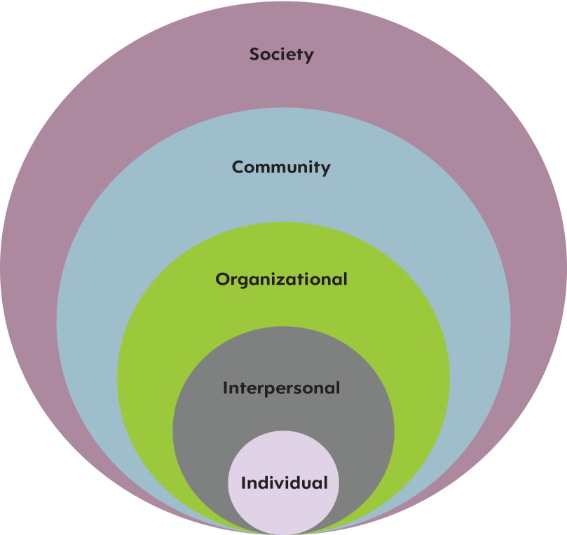Your message has been forwarded to our team and we will respond to you shortly.
The HHSP incorporates principles of the Social Ecological Model and is organized into four sector areas: Community Design and Access, Education, Health Care, and Worksite. The plan prioritizes goals, objectives, and strategies that lead to policy, systems, and environmental change. Objectives were developed using current data, best practices, and evidence-based science, and reflect one or more cross-cutting themes. Stakeholders utilized this common framework to develop objectives covering the program areas of asthma, cancer, diabetes, heart disease and stroke, physical activity and nutrition, and tobacco.
To align with national priorities and direction, the HHSP relies on the Social Ecological Model. This model recognizes the interwoven relationship that exists between the individual and their environment. While individuals are responsible for maintaining a healthy lifestyle, behavior can be largely determined by the environment in which they live through social norms, attitudes, and public policies. Effective chronic disease prevention programs should address multiple levels of the model with attention on policy, systems, and environmental change.

Integral to the framework and design of the HHSP is the focus on policy, systems, and environmental change. The plan’s long-term goals, objectives, and strategies were developed to align with national guidelines and recommendations and to reflect or lead to policy, systems, or environmental change.
Institutionalizing new rules or procedures as well as passing laws, ordinances, or resolutions are examples of policy changes.
Systems change and policy change often work hand-in-hand. Often systems change focuses on changing infrastructure within a school, park, worksite, or health setting.
Physical (structural changes or programs or service), social (a positive change in attitudes or behavior about policies that promote health) and economic factors (presence of financial disincentives or incentives to encourage a desired behavior).
| Epidemiology, Surveillance, and Evaluation | Epidemiology, surveillance, and evaluation should be used to understand the effectiveness and progress in achieving a plan’s goals and objectives. Data should be utilized to monitor progress, address gaps in health improvements, and prioritize next steps. |
|---|---|
| Quality of Life | Quality of life can encompass many areas of life, such as psychological well-being, social life, support system, health status and function, and functional or career well-being. |
| Community Clinical Linkages | Community clinical links help ensure that people with or at high risk of chronic diseases have access to the resources they need to prevent or manage these diseases. Improved links between the community and clinical setting offer community delivery of proven programs that clinicians can refer patients to. |
| Health Equity | Health disparities exist when there is a major difference in a health outcome between population groups. Prevention and chronic disease plans should recognize the importance of addressing health equity and prioritize population groups more likely to experience poor health outcomes. |
| Public Education and Communications | Public education and communications can be used as strategic tools to influence people, places, and environmental conditions. Public education and communication can be priortize to advance the goals and objectives of each prevention and chronic disease plan. |
| Coordination | A coordinated approach and common vision are essential to achieving the goals and objectives of this framework. Cross-coalition collaboration, greater information sharing, and the leveraging of resources will provide a more effective approach to implementing the policy, systems, and environmental change necessary to support healthy lifestyles and reduce premature death due to chronic disease. |
The HHSP also utilizes a framework of four sectors: Community Design and Access, Education, Health Care, and Worksite. This approach acknowledges the complexity of disease origins and promotes strategies that occur in multiple settings, e.g., where people live, learn, work, and play. Policy, systems, and environmental change in each of these settings will allow healthy options to become the easiest choice for Hawaiʻi residents.
Places (both physical & virtual) where policy, systems, and environmental change can be established to support the formation and maintenance of healthy behaviors, achieving health equity, and maximizing chronic disease prevention, management, and treatment.
Additionally, the HHSP supports and reinforces the following comprehensive, chronic disease prevention and management strategic plans for the state: